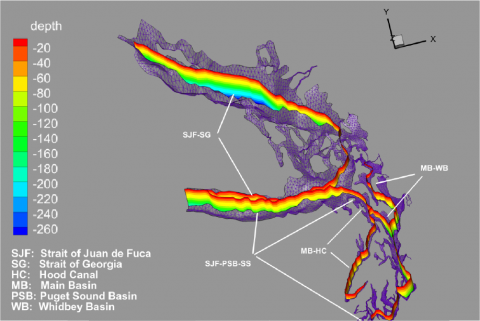SSM Water Quality: Dissolved Oxygen
Puget Sound DO Modeling Study: Development of an Intermediate-Scale Hydrodynamic and Water-Quality Model

The Puget Sound Dissolved Oxygen (DO) Modeling study was conducted under a U.S. Environmental Protection Agency (EPA) cooperative agreement with PNNL, Ecology, and the University of Washington awarded under the National Estuary Program. The objective of the project is to simulate algae growth, (DO), and nutrient dynamics in Puget Sound to inform potential Puget Sound-wide nutrient management strategies. Specifically, the project is expected to help determine 1) if current and potential future nitrogen loadings from point and nonpoint sources are significantly impairing water quality at a large scale, and 2) what level of nutrient reductions are necessary to reduce or control human impacts on DO levels in the sensitive areas.

to the Puget Sound Basin to the South Sound.
The model setup and calibration details are provided under the Salish Sea Model (SSM) Hydrodynamics and Water Quality tabs. Also visit the Ecology project site (Puget Sound DO Model) for archives of model sensitivity tests and calibration error analysis statistics. A report summarizing the results of sensitivity tests to assess the Impacts of Current and Future Human Nitrogen Sources and Climate Change through 2070 is in progress (Roberts et al. 2014).
An example simulation of phytoplankton bloom in Whidbey Basin of Puget Sound is shown below. Weekly running average concentrations of chlorophyll a advanced at the rate of 6 hours per frame are shown over a 10-day period in April 2006. This corresponds to the annual spring bloom of diatoms.

April of 2006.
Project Highlights
The development of the Salish Sea Model (SSM) model primarily occurred as a result of this project. The project supported the construction of an offline intermediate-scale water-quality model for the Salish Sea domain (Puget Sound and Georgia Basins) using the scalar transport scheme from the Finite Volume Coastal Ocean Model (FVCOM), coupled with biogeochemical code of CE-QUAL-ICM. A total of 19 state variables and key biogeochemical processes, including phytoplankton bloom dynamics, nutrient uptake, and re-mineralization, were simulated. The model includes nutrient loads from the ocean boundary, 19 major rivers, 64 nonpoint sources, and 99 point sources of wastewater discharge. Calibration of the model was conducted using observed water-quality data (chlorophyll a, nutrients, and DO) from the year 2006 and using numerous sensitivity tests and best professional judgment to guide model parameter adjustment.
Of importance to biogeochemical computations in Puget Sound is the ability of the model to simulate tidal residual inflow and bottom-water renewal. The figure above shows plots of mean annual inflows and outflows computed at selected sections in the basin from the year 2006 solution and shows characteristic features such as inflow at depth and outflow through the mixed near-surface layers.
We have used two species of algae (diatoms and dinoflagellates) to re-create the seasonal variation through spring and summer bloom peaks. However, without specific data on each algal type, the model relies on best professional judgment to adjust the phytoplankton succession. Similarly, zooplankton data were not available for this calibration effort. As a result, zooplanktons were not simulated explicitly, but the effect was incorporated in the form of predation rate, which is a function of algal biomass and temperature. Although a total of 99 wastewater point sources and the effect of the mass loading of nutrient and carbon from the point sources on DO kinetics were included, the resolution at each outfall is insufficient for use in near-field mixing zone analyses.
Despite many limitations, as one of the first efforts to simulate biogeochemical balance over the entire Salish Sea domain using a numerical model, the performance in simulating observed behavior is encouraging. The current model calibration is suitable for addressing the broad water-quality management question of whether human sources of nutrients in and around Puget Sound are significantly affecting water quality and, if so, how much nutrient reduction is necessary to reduce human impacts in sensitive areas. While targeted future improvements and refinements to the model are ongoing, the study has already yielded quantitative information about the relative impacts of nutrient loads on DO from rivers, outfalls, and potential changes caused by future loads and climate change. Numerous sensitivity tests have provided valuable insight into the importance of upwelled water that enters Puget Sound in the lower layers of the water column, its role in mixing, and the importance of reflux at the Admiralty Sill as seen in the first panel of the example above.
Project Team
View full list of contacts and project teams.